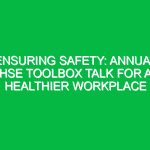Introduction
In the realm of Health, Safety, and Environment (HSE), the term “confined” takes on profound significance. To define confined is to understand spaces that are not only limited in access but also pose unique risks that can endanger workers. Confined spaces, such as tanks, vessels, silos, and pipelines, can become hazardous environments due to factors like toxic gases, low oxygen levels, or the potential for engulfment. Recognizing and managing these risks is crucial for ensuring workplace safety and compliance with regulatory standards. This article delves into the essence of confined spaces in the HSE context, exploring critical insights, guidelines, and real-world applications.
Understanding Confined Spaces
Confined spaces are defined as areas that are large enough for an employee to enter and perform work, but have limited means of entry or exit. According to the Occupational Safety and Health Administration (OSHA), such spaces are not designed for continuous occupancy. This definition is critical because it underscores both the physical limitations of these areas and the potential hazards that can arise.
Key Characteristics of Confined Spaces
To effectively manage confined spaces, it’s essential to identify their key characteristics:
- Limited Entry and Exit: These spaces often have small openings that make access difficult, complicating rescue efforts in emergencies.
- Poor Ventilation: Many confined spaces lack adequate airflow, leading to the accumulation of harmful substances.
- Potential for Hazardous Atmospheres: The air quality in confined spaces can be compromised by toxic gases, vapors, or insufficient oxygen levels.
- Engulfment Risks: Some confined spaces, such as grain silos, pose risks of engulfment by materials.
Understanding these characteristics is imperative for any safety manager or employee involved in HSE practices, as they form the basis for risk assessment and safety planning.
Potential Hazards in Confined Spaces
The hazards associated with confined spaces can vary widely based on the nature of the work and the environment. Here are some common risks:
- Toxic Exposure: Chemicals, gases, and vapors can be present, often without immediate detection.
- Oxygen Deficiency: The normal oxygen level in the atmosphere is about 20.9%. Levels below 19.5% can impair cognitive and physical performance.
- Engulfment: Loose materials can engulf a worker, leading to suffocation.
- Temperature Extremes: High heat or cold can pose additional risks in confined environments.
Real-life incidents, such as the tragic deaths of workers in a grain silo due to engulfment, illustrate the critical importance of understanding these risks. In one such case, a worker entered a silo without proper safety measures and was engulfed by flowing grain. This incident underscores the urgent need for rigorous safety protocols.
Best Practices for Working in Confined Spaces
Effective management of confined spaces involves a combination of thorough planning, training, and adherence to safety protocols. Here are some best practices:
1. Conduct Risk Assessments
Before any work begins in a confined space, a comprehensive risk assessment must be conducted. This process involves identifying potential hazards, evaluating risks, and implementing control measures. For instance, if a space is found to contain toxic gases, proper ventilation or respiratory protection should be provided.
2. Permit-Required Confined Space Program
Implementing a permit-required confined space (PRCS) program is vital. This program should outline the procedures for entering, working in, and exiting confined spaces. It typically includes:
- Evaluating the space for hazards
- Implementing safety measures
- Designating a competent person to oversee the operation
3. Training and Education
All employees who may enter confined spaces should receive training that covers safety protocols, hazard recognition, and emergency response. Engaging workers through simulations or drills can enhance their preparedness and confidence when faced with real situations.
4. Monitoring Atmospheric Conditions
Before and during entry into a confined space, continuous monitoring of the atmosphere is crucial. Utilizing gas detection equipment can help ensure that oxygen levels are safe and that no harmful gases are present.
5. Emergency Preparedness
Having a robust emergency response plan is non-negotiable. The plan should include procedures for evacuation, rescue operations, and first aid. Regular drills will ensure that all personnel are familiar with these procedures and can act quickly in case of an emergency.
Regulations and Standards Governing Confined Spaces
Compliance with regulations is essential for managing confined spaces effectively. In the U.S., OSHA‘s standards for confined spaces, outlined in 29 CFR 1910.146, provide a comprehensive framework for safety practices. These regulations specify the requirements for identifying and assessing confined spaces, training employees, and implementing safety measures.
Key Regulations Include:
- Hazard Assessment: Employers must assess the work environment to identify confined spaces and the associated hazards.
- Training Requirements: Workers must be trained in the hazards of confined spaces and safe practices.
- Rescue Plans: Employers must establish procedures for rescuing workers from confined spaces.
- Permit Systems: For permit-required confined spaces, a system must be in place to control entry and ensure safety measures are followed.
Understanding and adhering to these regulations not only safeguard workers but also help organizations avoid legal repercussions and financial losses.
Conclusion
Defining confined spaces within the HSE context is not merely an academic exercise; it is a matter of life and death in many industries. The risks associated with confined spaces are numerous and often hidden, requiring a proactive approach to safety. By implementing best practices, conducting thorough training, and adhering to regulatory standards, organizations can significantly mitigate these risks.
The importance of defining confined spaces and understanding their implications cannot be overstated. In an age where safety is paramount, it is imperative that all stakeholders take the necessary steps to ensure that workers can perform their duties without undue risk to their health and safety. As we continue to engage with this critical aspect of HSE, let us prioritize awareness, training, and a culture of safety that extends beyond compliance to embrace a genuine commitment to worker well-being.
As you reflect on the insights shared in this article, consider what steps you or your organization can take to improve safety practices related to confined spaces. The journey towards a safer work environment begins with a single, informed decision.


